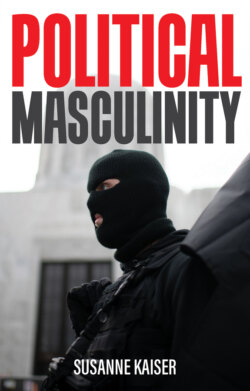Читать книгу Political Masculinity - Susanne Kaiser - Страница 8
Notes
Оглавление1 1. Madison Pauly, ‘The War on Masks is a Cover-Up for Toxic Masculinity: How Flouting Public Health Guidelines Became Synonymous with Manliness’, Mother Jones (8 October 2020), www.motherjones.com/coronavirus-updates/2020/10/trump-masks-covid-toxic-masculinity/?utm_source=facebook&utm_campaign=naytev&utm_medium=social.
2 2. Magazines, newspapers and news broadcasters such as the New York Times, the Guardian, Forbes, CNN – but also non-Western media outlets such as the Indian journal Yourstory – have lauded this ‘new leadership style’ as highly promising and future-oriented ‘in a new era of global threats’. The general conclusion is expressed neatly in the title of an article by Michelle P. King: ‘Women Are Better Leaders: The Pandemic Proves It’. See, for example, Avivah Wittenberg-Cox, ‘What Do Countries with the Best Coronavirus Responses Have in Common? Women Leaders’, Forbes (13 April 2020), www.forbes.com/sites/avivahwittenbergcox/2020/04/13/what-do-countries-with-the-best-coronavirus-reponses-have-in-common-women-leaders/?sh=6620923c3dec; Leta Hong Fincher, ‘Women Leaders Are Doing a Disproportionately Great Job at Handling the Pandemic: So Why Aren’t There More of Them?’ CNN.com (16 April 2020), www.cnn.com/2020/04/14/asia/women-government-leaders-coronavirus-hnk-intl/index.html; John Henley and Eleanor Ainge Roy, ‘Are Female Leaders More Successful at Managing the Coronavirus Crisis?’ The Guardian (25 April 2020), www.theguardian.com/world/2020/apr/25/why-do-female-leaders-seem-to-be-more-successful-at-managing-the-coronavirus-crisis; Amanda Taub, ‘Why Are Women-Led Nations Doing Better with Covid-19?’ New York Times (18 May 2020), www.nytimes.com/2020/05/15/world/coronavirus-women-leaders.html; and Nirandhi Gowthaman, ‘Coronavirus: How Have Women-Led Countries Flattened the Curve?’ Yourstory (17 April 2020), https://yourstory.com/herstory/2020/04/coronavirus-women-led-countries-flattened-curve. For King’s article, see CNN.com (5 May 2020), www.cnn.com/2020/05/05/perspectives/women-leaders-coronavirus/index.html.
3 3. Gemma D’Auria and Aaron De Smet, ‘Leadership in a Crisis: Responding to the Coronavirus Outbreak and Future Challenges’, McKinsey & Company (16 March 2020), www.mckinsey.com/business-functions/organization/our-insights/leadership-in-a-crisis-responding-to-the-coronavirus-outbreak-and-future-challenges#.
4 4. Haig’s post can be viewed online at www.instagram.com/p/B_NVSj5pv7R.
5 5. See, for example, ‘Weibliche Stimmen im Fußball: Hass gegen Kommentatorinnen macht Schule’, ntv.de (22 June 2018), www.n-tv.de/sport/fussball_wm_2018/Hass-gegen-Kommentatorinnen-macht-Schule-article20493382.html.
6 6. The trailer can be viewed online at www.youtube.com/watch?v=w3ugHP-yZXw&app=desktop%7D.
7 7. The trailer is available online at www.youtube.com/watch?v=8Qn_spdM5Zg.
8 8. Caroline Criado Perez, Invisible Women: Exposing Data Bias in a World Designed for Men (London: Chatto & Windus, 2019).
9 9. The term ‘political masculinities’ was introduced in 2014 by the gender researchers Birgit Sauer and Kathleen Starck. In the introduction to their anthology A Man’s World? Political Masculinities in Literature and Culture (Newcastle: Cambridge Scholars Publishing, 2014), pp. 3–10, they take a cultural-theoretical approach and define the term as ‘[e]ncompass[ing] any kind of masculinity that is constructed around, ascribed to and/or claimed by “political players”. These are individuals or groups of persons who are part of or associated with the “political domain”, i.e., professional politicians, party members, members of the military as well as citizens and members of political movements claiming or gaining political rights’ (p. 6). In the preface to their collection Political Masculinities and Social Transition (special issue of Men and Masculinities 22 (2019), pp. 3–19), Kathleen Starck and Russell Luyt use the term ‘political masculinities’ to denote broader contexts of social transition: ‘Whilst we fully agree that gender, and masculinities, are inextricably political concepts in the (re)production of power, the concept of political masculinities can usefully be applied in instances in which power is explicitly either being (re)produced or challenged’ (p. 10). Overall, these concepts of ‘political masculinities’ are far broader and based on a more consistent theory than the concept of political masculinity, as I understand it and analyse it in this book. This is clear to see in the most recent anthology edited by Starck and Luyt, Masculine Power and Gender Equality: Masculinities as Change Agents (Cham: Springer, 2020). Here, instead of focusing exclusively on hegemonic masculinity, the authors include, in their understanding of political masculinities, the concept of ‘change agents for gender equality’.
10 10. See Maya Oppenheim, ‘Trump Administration “Rolling Back Women’s Rights by 50 Years” by Changing Definitions of Domestic Violence and Sexual Assault’, Independent (24 January 2019), www.independent.co.uk/news/world/americas/trump-domestic-abuse-sexual-assault-definition-womens-rights-justice-department-a8744546.html.
11 11. Sarah Maslin Nir, ‘The Misogynistic “Dating Coach” Who Was Charged in the Capitol Riot’, New York Times (4 February 2021), www.nytimes.com/2021/02/04/nyregion/samuel-fisher-capitol-riot.html.
